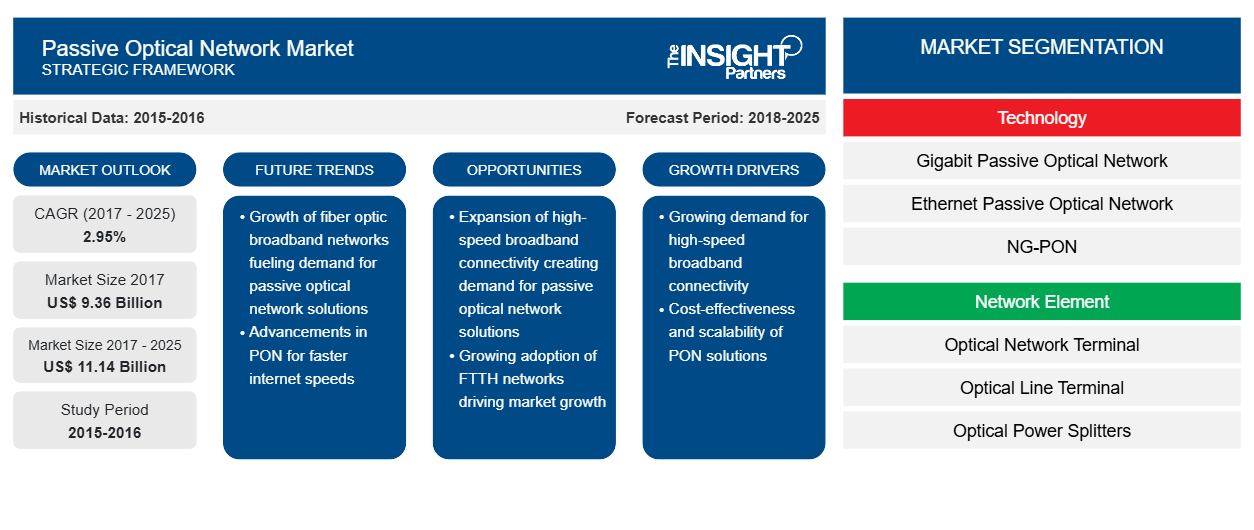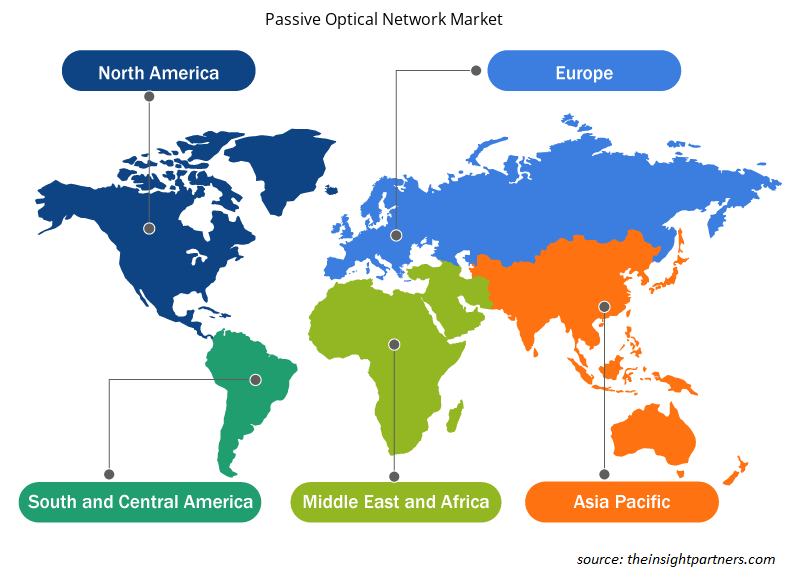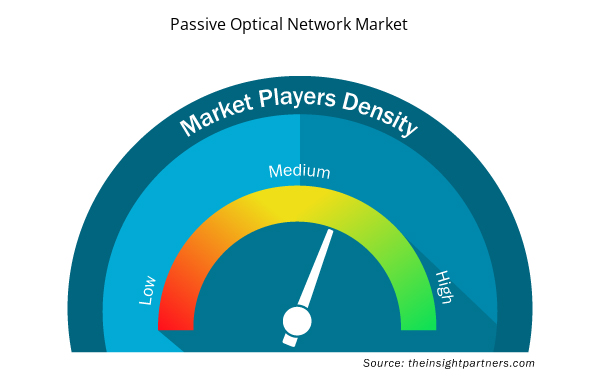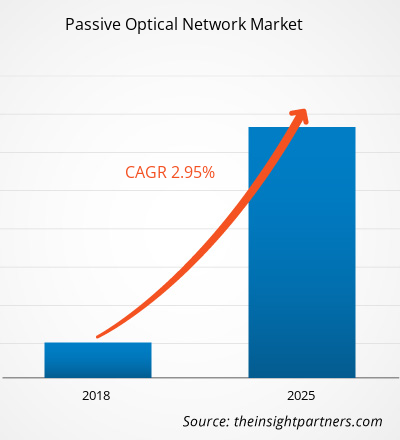The passive optical network market was valued at US$ 9,359.1 million in 2017 and is projected to reach US$ 11,144.6 million by 2025; it is expected to grow at a CAGR of 2.95% during 2018–2025.
A passive optical network (PON) is a fiber-optic telecommunications technology that provides end-customers with broadband network connectivity. Its architecture uses a point-to-multipoint topology, in which a single optical fibre serves multiple endpoints by dividing the fibre bandwidth among multiple access points using unpowered (passive) fibre optic splitters. The demand for Gigabyte Passive Optical Network (GPON) equipment will increase due to the increasing penetration of telecom and internet services, as well as the growing need for bandwidth. Data-intensive applications like video on demand, videoconferencing, and Voice over Internet Protocol (VoIP) are predicted to increase demand for Ethernet Passive Optical Network (EPON) equipment development.
In comparison to other conventional networks, rising awareness of global warming has led to a rise in demand for eco-friendly solutions throughout the world. In addition, rising demand for safe, secure, and dependable operations, as well as increased digitalization, are likely to drive the passive optical network market demand. Growing demand for high-speed networks at home for accessing smart technologies, as well as increasing fiber-to-the-home deployments for rapid access to data, videos, voice, and services, are all adding to the rise. Over the projection period, demand is likely to be driven by the increasing penetration of smart grids, e-governance services, and cloud computing.
Customize This Report To Suit Your Requirement
You will get customization on any report - free of charge - including parts of this report, or country-level analysis, Excel Data pack, as well as avail great offers and discounts for start-ups & universities
Passive Optical Network Market: Strategic Insights

- Get Top Key Market Trends of this report.This FREE sample will include data analysis, ranging from market trends to estimates and forecasts.
Customize This Report To Suit Your Requirement
You will get customization on any report - free of charge - including parts of this report, or country-level analysis, Excel Data pack, as well as avail great offers and discounts for start-ups & universities
Passive Optical Network Market: Strategic Insights

- Get Top Key Market Trends of this report.This FREE sample will include data analysis, ranging from market trends to estimates and forecasts.
Market Insights–Passive optical network Market
Internet of Things (IoT) is Paving Path for Passive Optical Networks
The Internet of Things (IoT) involves connecting number of devices through a single source, which is achieved through deployment of passive optical network. The global connected devices industry is anticipated to witness an exponential growth over the next five years. The Internet of Things driven products is expected to account for three times the global population over the years. This is due to the rapid technological acceleration, which is increasing the adoption of Internet of Things in every sector. The upsurge in advanced sensors production, and rise in sophistication of cognitive analytics will enable every device to provide feedback with the help of IoT. Passive optical network plays an important role in connecting devices. PON is manageable and scalable, which makes the system flexible. The IoT demands for centralized architecture, and intelligent management, which are key characteristics of PON. In addition, the PON is capable of transmitting data to 32 users at a time, with only one terminal at the source. This facilitates heavily in connecting number of devices through one source terminal. The PON poses various advantages in connecting devices, such as more space, improved scalability, enhanced security, and lowers costs. Attributing to no usage of switches, and no need of cables, number of telecom rooms are used for other purposes, thus, POL is helping in freeing up space. The PON uses less wirings as compared to traditional systems, which increases the ability to scale the system as per the requirement. The Ethernet ports are locked with PON, which need two way access to open, thereby minimizing the risk of data breaching and enhancing the security with PON. As PON utilizes less components and space, the Capex and Opex is greatly reduced as compared to other data transmission systems. Pertaining to these advantages of PON over legacy systems, the Internet of Things service providers are increasingly adopting the robust technology
Technology Insight
Based on the global passive optical network market can be bifurcated into gigabit passive optical network (GPON), ethernet passive optical network (EPON), and others (NG-PON). The demand for internet has witnessed exponential demands in the last few years and with more internet based applications on the plate, this demand is projected to reach unprecedented levels. Sensing an opportunity as a result of exponential demands, the network service providers and internet service providers intend to be prepared to handle large data traffics over the network and satiate the requirements of each and every individual user. A PON being a point-to-multipoint system, it is capable of transmitting data more efficiently. As the main transmission line can be split up into many small separate lines, the infrastructure requirement in this type of architecture is reduced greatly. While all PONs use optical cables and unpowered splitters, there are several different versions. Each different type of PON has a unique upstream and downstream data transmission capability. Also, each type of PON network uses a different multiplexing technology for transmission of data over the network. These different short-haul networks of the fiber-optical cable are used for internet access, Voice over Internet Protocol (VoIP), digital TV delivery, backhaul connections for cellular base-stations, Wi-Fi hotspots, and distributed antenna systems (DAS).
Network Element Segment Insight
The network element segment in passive optical network market include Optical Line Terminal (OLT), Optical Network Terminal (ONT), and Optical Power Splitters. PON is applicable for data-centric networks, as well as full-service voice, data and video networks. The next generation in development of access networks. Ultimately, they can offer the largest bandwidth at the lowest cost. Industry experts anticipate that network-related capital expenditures by telecommunication operators need to be increased at least by 60% for efficient and seamless application of Passive Optical Network technology in the near future from 2017 for a period of 4-5 years which would approximately be double of the Total Cost of Ownership (TCO) during the period. The optical network terminal segment in the passive optical network market is expected to surge at an exponential rate during the forecast period.
Application Segment Insight
The application segment in passive optical network market include Fiber to the home (FTTH), other Fiber to the building (FTTX), and Mobile Backhaul. Many implementations still use copper cabling to deliver signals to the premises, but prove to be inefficient and insufficient to efficiently transport data over the highly crowded network in the recent times. Increasing demands for providing consumers with higher bandwidths, and the emergence of internet based applications have multiplied traffics over the network. The communication carriers have been seeking to offer a matured and a robust network convergence that would enable high speed data transfers for the consumers and allow for accessing applications such as live TV streaming, voice, video and other applications simultaneously over the same network. The mobile backhaul segment in the passive optical network market is expected to surge at a prime rate during the forecast period.
Market initiative was observed as the most adopted strategy in global passive optical network industry. Few of the market initiative are listed below;
2018:Motorola Solutions acquired Avigilon (Canada) which develops advanced video surveillance and analytics solutions. The acquisition aims to provide advanced video surveillance and analytics solutions to government, commercial customers, and public safety, clients of Motorola Solutions
2018:Nokia and AT&T plans to improve, examine, and promote the next generation of IoT services to transform industries such as manufacturing, transportation, utilities, retail, health, consumer electronics agriculture, and smart cities
2018:Calix showcased new cloud competencies to enable service providers in the process of identification of customer needs and to mechanically address Wi-Fi network performances and device connectivity issues to have satisfied customer base
Passive Optical Network Market Regional Insights
Passive Optical Network Market Regional Insights
The regional trends and factors influencing the Passive Optical Network Market throughout the forecast period have been thoroughly explained by the analysts at Insight Partners. This section also discusses Passive Optical Network Market segments and geography across North America, Europe, Asia Pacific, Middle East and Africa, and South and Central America.

- Get the Regional Specific Data for Passive Optical Network Market
Passive Optical Network Market Report Scope
| Report Attribute | Details |
|---|---|
| Market size in 2017 | US$ 9.36 Billion |
| Market Size by 2025 | US$ 11.14 Billion |
| Global CAGR (2017 - 2025) | 2.95% |
| Historical Data | 2015-2016 |
| Forecast period | 2018-2025 |
| Segments Covered |
By Technology
|
| Regions and Countries Covered | North America
|
| Market leaders and key company profiles |
Passive Optical Network Market Players Density: Understanding Its Impact on Business Dynamics
The Passive Optical Network Market market is growing rapidly, driven by increasing end-user demand due to factors such as evolving consumer preferences, technological advancements, and greater awareness of the product's benefits. As demand rises, businesses are expanding their offerings, innovating to meet consumer needs, and capitalizing on emerging trends, which further fuels market growth.
Market players density refers to the distribution of firms or companies operating within a particular market or industry. It indicates how many competitors (market players) are present in a given market space relative to its size or total market value.
Major Companies operating in the Passive Optical Network Market are:
- Adtran, Inc.
- Adva Optical Networking Se
- Calix, Inc.
- Ciena Corporation
- Cisco Systems, Inc.
Disclaimer: The companies listed above are not ranked in any particular order.

- Get the Passive Optical Network Market top key players overview
BY TECHNOLOGY
- Gigabit Passive Optical Network (GPON)
- Ethernet Passive Optical Network (EPON)
- Others
BY NETWORK ELEMENTS
BY NETWORK ELEMENTS
- Optical Network Terminal (ONT)
- Optical Line Terminal (OLT)
- Optical Power Splitters
BY APPLICATION
BY APPLICATION
- Residential Service (FTTH)
- Business Service (Other FTTx)
- Mobile Backhaul
BY GEOGRAPHY
BY GEOGRAPHY
North America
- U.S.
- Canada
- Mexico
Europe
- France
- Germany
- Italy
- Spain
- U.K.
Asia Pacific (APAC)
- Australia
- China
- India
- Japan
Middle East & Africa (MEA)
- Saudi Arabia
- U.A.E.
- South Africa
South America (SA)
- Brazil
COMPANY PROFILES
- Adtran Inc.
- Adva Optical Networking SE
- Calix, Inc.
- Ciena Corporation
- Cisco Systems, Inc.
- Huawei Technologies Co., Ltd.
- Infinera Corporation
- Motorola Solutions, Inc.
- Nokia Corporation
- ZTE Corporation
- Historical Analysis (2 Years), Base Year, Forecast (7 Years) with CAGR
- PEST and SWOT Analysis
- Market Size Value / Volume - Global, Regional, Country
- Industry and Competitive Landscape
- Excel Dataset



Report Coverage
Revenue forecast, Company Analysis, Industry landscape, Growth factors, and Trends

Segment Covered
Technology ; Network Element ; and Applications

Regional Scope
North America, Europe, Asia Pacific, Middle East & Africa, South & Central America

Country Scope
US, Canada, Mexico, UK, Germany, Spain, Italy, France, India, China, Japan, South Korea, Australia, UAE, Saudi Arabia, South Africa, Brazil, Argentina
Trends and growth analysis reports related to Electronics and Semiconductor : READ MORE..
The List of Companies
1. Adtran, Inc.
2. Adva Optical Networking Se
3. Calix, Inc.
4. Ciena Corporation
5. Cisco Systems, Inc.
6. Huawei Technologies Co., Ltd.
7. Infinera Corporation
8. Motorola Solutions, Inc.
9. Nokia Corporation
10. ZTE Corporation

 Get Free Sample For
Get Free Sample For